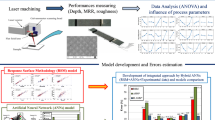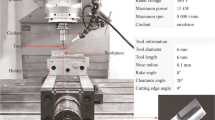Abstract
Compared with the traditional abrasive flow, cavitation abrasive flow can effectively improve the kinetic energy and motion randomness of abrasive particles during the polishing process without changing the polishing pressure, thus reducing the scratch and damage caused by hard and large particles on the surface and subsurface of monocrystalline silicon, and efficaciously improve the surface quality of polished silicon wafer. Polishing parameters have a significant influence on the surface roughness of abrasive flow polished workpiece. However, it is more complex to optimize the polishing process parameters for cavitation abrasive flow. The traditional process optimization methods, such as the full factorial experiment and Taguchi experiment, are discrete and time-consuming, making it difficult to meet the requirements of cavitation abrasive flow polishing parameters optimization. In order to solve the above problems, based on cavitation rotary abrasive flow polishing (CRAFP) system, a new process parameter optimization method is proposed in this paper: samples are generated by Taguchi experiment, and then a model between the surface roughness of silicon wafer and the factors affecting the surface roughness is established using backpropagation (BP) neural network. Finally, the optimal process parameters are found by genetic algorithm based on this model. The experimental results show that the optimum process parameters are 0.7 um SiC abrasive particles, 12% concentration, 6 nozzles, 0.8 mm from the tool surface to the workpiece, and 0.45-MPa inlet pressure. Under this condition, the average surface roughness (Ra) of the workpiece is reduced from 35.44 to 3.43 nm, improved by 90.32%. The final optimization effect is proved superior to the single Taguchi method optimization and genetic algorithm coupling with response surface model.













Similar content being viewed by others
Data availability
All data generated or analyzed during this study are included in this published article.
Materials availability
All data generated or analyzed during this study are included in this published article.
References
Guo Y, Wang N, Xu Z-Y, Wu K (2020) The internet of things-based decision support system for information processing in intelligent manufacturing using data mining technology. Mechanical Systems and Signal Processing 142:106630
Zhong RY, Xu X, Klotz E, Newman ST (2017) Intelligent manufacturing in the context of Industry 4.0: a review. Engineering 3:616–630
Lu Y, Xu X, Wang L (2020) Smart manufacturing process and system automation – a critical review of the standards and envisioned scenarios. Journal of Manufacturing Systems 56:312–325
Pacaux-Lemoine M-P, Trentesaux D, Zambrano Rey G, Millot P (2017) Designing intelligent manufacturing systems through Human-Machine Cooperation principles: a human-centered approach. Computers & Industrial Engineering 111:581–595
Zhang C, Zhou G, Hu J, Li J (2020) Deep learning-enabled intelligent process planning for digital twin manufacturing cell. Knowledge-Based Systems 191:105247
Hegde S, Babu SV (2003) Removal of shallow and deep scratches and pits from polished copper films. Electrochemical and Solid-State Letters 6:G126–G129
Hahn PO (2001) The 300 mm silicon wafer — a cost and technology challenge. Microelectronic Engineering 56:3–13
Fan C, Hong G-S, Zhao J, Zhang L, Zhao J, Sun L (2019) The integral sliding mode control of a pneumatic force servo for the polishing process. Precision Engineering 55:154–170
Ji S, Cao H, Zhao J, Pan Y, Jiang E (2019) Soft abrasive flow polishing based on the cavitation effect. The International Journal of Advanced Manufacturing Technology 101:1865–1878
Zhao J, Jiang E, Qi H, Ji S, Chen Z (2020) A novel polishing method for single-crystal silicon using the cavitation rotary abrasive flow. Precision Engineering 61:72–81
Zhao J, Huang J, Wang R, Peng H, Hang W, Ji S (2020) Investigation of the optimal parameters for the surface finish of K9 optical glass using a soft abrasive rotary flow polishing process. Journal of Manufacturing Processes 49:26–34
Liang F, Kang C, Fang F (2020) A review on tool orientation planning in multi-axis machining. International Journal of Production Research 1–31
Zhao J, Huang J, Xiang Y, Wang R, Xu X, Ji S, Hang W (2021) Effect of a protective coating on the surface integrity of a microchannel produced by microultrasonic machining. Journal of Manufacturing Processes 61:280–295
Han Y, Zhu W, Zhang L, Beaucamp A (2020) Region adaptive scheduling for time-dependent processes with optimal use of machine dynamics. International Journal of Machine Tools and Manufacture 156:103589
Shiou F-J, Asmare A (2015) Parameters optimization on surface roughness improvement of Zerodur optical glass using an innovative rotary abrasive fluid multi-jet polishing process. Precision Engineering 42:93–100
Zhao J, Wang R, Huang J, Hu B, Ji S (2020) Micro ultrasonic machining hemispherical mold for MEMS resonator gyroscope using a novel ultraprecise ceramic entire-ball tool. Journal of Micromechanics and Microengineering 30:075007
Fan C, Xue Y, Zhang L, Zhao Q, Lu Y, Wang Q (2020) Investigation into the error compensation method of the surface form based on feed rate optimization in deterministic polishing. Machining Science and Technology 1–21
Hou T-H, Su C-H, Liu W-L (2007) Parameters optimization of a nano-particle wet milling process using the Taguchi method, response surface method and genetic algorithm. Powder Technology 173:153–162
Mia M, Dhar NR (2016) Prediction of surface roughness in hard turning under high pressure coolant using artificial neural network. Measurement 92:464–474
Ozcelik B, Oktem H, Kurtaran H (2005) Optimum surface roughness in end milling Inconel 718 by coupling neural network model and genetic algorithm. The International Journal of Advanced Manufacturing Technology 27:234–241
Kurtaran H, Ozcelik B, Erzurumlu T (2005) Warpage optimization of a bus ceiling lamp base using neural network model and genetic algorithm. Journal of Materials Processing Technology 169:314–319
Booij SM (2004) Fluid jet polishing: possibilities and limitations of a new fabrication technique.
Liang F, Kang C, Fang F (2020) A smooth tool path planning method on NURBS surface based on the shortest boundary geodesic map. Journal of Manufacturing Processes 58:646–658
Messelink WA, Waeger R, Wons T, Meeder M, Heiniger KC, Faehnle OW (2005) Prepolishing and finishing of optical surfaces using fluid jet polishing. In: Optical manufacturing and testing VI. International Society for Optics and Photonics, p 586908
Schmidt DP, Rutland CJ, Corradini ML (1997) A numerical study of cavitating flow through various nozzle shapes. SAE Transactions 106:1664–1673
Han Y, Duan F, Zhu W, Zhang L, Beaucamp A (2020) Analytical and stochastic modeling of surface topography in time-dependent sub-aperture processing. International Journal of Mechanical Sciences 175:105575
Li M, Bussonnière A, Bronson M, Xu Z, Liu Q (2019) Study of Venturi tube geometry on the hydrodynamic cavitation for the generation of microbubbles. Minerals Engineering 132:268–274
Shi H, Li M, Nikrityuk P, Liu Q (2019) Experimental and numerical study of cavitation flows in venturi tubes: From CFD to an empirical model. Chemical Engineering Science 207:672–687
Altan M (2010) Reducing shrinkage in injection moldings via the Taguchi, ANOVA and neural network methods. Materials & Design 31:599–604
Sreenivasulu R (2013) Optimization of surface roughness and delamination damage of GFRP composite material in end milling using Taguchi design method and artificial neural network. Procedia Engineering 64:785–794
Oliaei E, Heidari BS, Davachi SM, Bahrami M, Davoodi S, Hejazi I, Seyfi J (2016) Warpage and shrinkage optimization of injection-molded plastic spoon parts for biodegradable polymers using Taguchi, ANOVA and artificial neural network methods. Journal of Materials Science & Technology 32:710–720
Qi H, Qin S, Cheng Z, Zou Y, Cai D, Wen D (2021) DEM and experimental study on the ultrasonic vibration-assisted abrasive finishing of WC-8Co cemented carbide cutting edge. Powder Technology 378:716–723
Huu Loc P, Shiou F-J, Yu Z-R, Hsu W-Y (2013) Investigation of optimal air-driving fluid jet polishing parameters for the surface finish of N-BK7 optical glass. J Manuf Sci Eng 135:011015
Xue H, Cui H (2019) Research on image restoration algorithms based on BP neural network. Journal of Visual Communication and Image Representation 59:204–209
Li B, Li Y, Wang H, Ma Y, Hu Q, Ge F (2018) Compensation of automatic weighing error of belt weigher based on BP neural network. Measurement 129:625–632
Geng X, Lu S, Jiang M, Sui Q, Lv S, Xiao H, Jia Y, Jia L (2018) Research on FBG-based CFRP structural damage identification using BP neural network. Photonic Sensors 8:168–175
Weidong W (2006) Optimizing regularized discriminant analysis in virtual training samples. Journal of Computer Aided Design and Computer Graphics 18:1327
Greve L, Schneider B, Eller T, Andres M, Martinez J-D, van de Weg B (2019) Necking-induced fracture prediction using an artificial neural network trained on virtual test data. Engineering Fracture Mechanics 219:106642
Zhang J-X, Chen Y-Z (2011) Optimization of the process parameters of Baeckeae oil-β-cyclodextrin inclusion complex by artificial neural network and genetic algorithm. Journal of China Pharmaceutical University 42:324–328
Qi H, Qin S, Cheng Z, Teng Q, Hong T, Xie Y (2021) Towards understanding performance enhancing mechanism of micro-holes on K9 glasses using ultrasonic vibration-assisted abrasive slurry jet. Journal of Manufacturing Processes In press
Bakhtiyari AN, Wang Z, Wang L, Zheng H (2021) A review on applications of artificial intelligence in modeling and optimization of laser beam machining. Optics & Laser Technology 135:106721
Funding
This paper was financially supported in part by the National Natural Science Foundation of China (Nos. 52075494, 51605438) and Zhejiang Provincial Natural Science Foundation of China (No. LY19E050005).
Author information
Authors and Affiliations
Contributions
Jun Zhao contributed to the conception of the study, designed the experiment, and performed the overall arrangement work; Rui Wang contributed significantly to data analysis, algorithm design, and manuscript composing; Enyong Jiang performed the experiment and manuscript preparation; and Shiming Ji contributed to the constructive discussions and contacted the funding source.
Corresponding author
Ethics declarations
Ethical approval and consent to participate
Ethical Approval and consent to participate are not applicable. The research in this article does not experiment on human and have no ethical issues. We ensure our research does not cause any mental or physical harm to humans and does not harm their safety and interests.
Consent for publication
Written informed consent for publication was obtained from all participants.
Competing Interests
The authors declare no competing interests.
Disclaimer
The Key Laboratory of Special Purpose Equipment and Advanced Processing Technology does not mind being the author’s unit. It also does not affect your decision to publish and share the results in your journals.
Additional information
Publisher’s note
Springer Nature remains neutral with regard to jurisdictional claims in published maps and institutional affiliations.
Rights and permissions
About this article
Cite this article
Zhao, J., Wang, R., Jiang, E. et al. Research on a new method for optimizing surface roughness of cavitation abrasive flow polishing monocrystalline silicon. Int J Adv Manuf Technol 113, 1649–1661 (2021). https://doi.org/10.1007/s00170-021-06667-6
Received:
Accepted:
Published:
Issue Date:
DOI: https://doi.org/10.1007/s00170-021-06667-6




